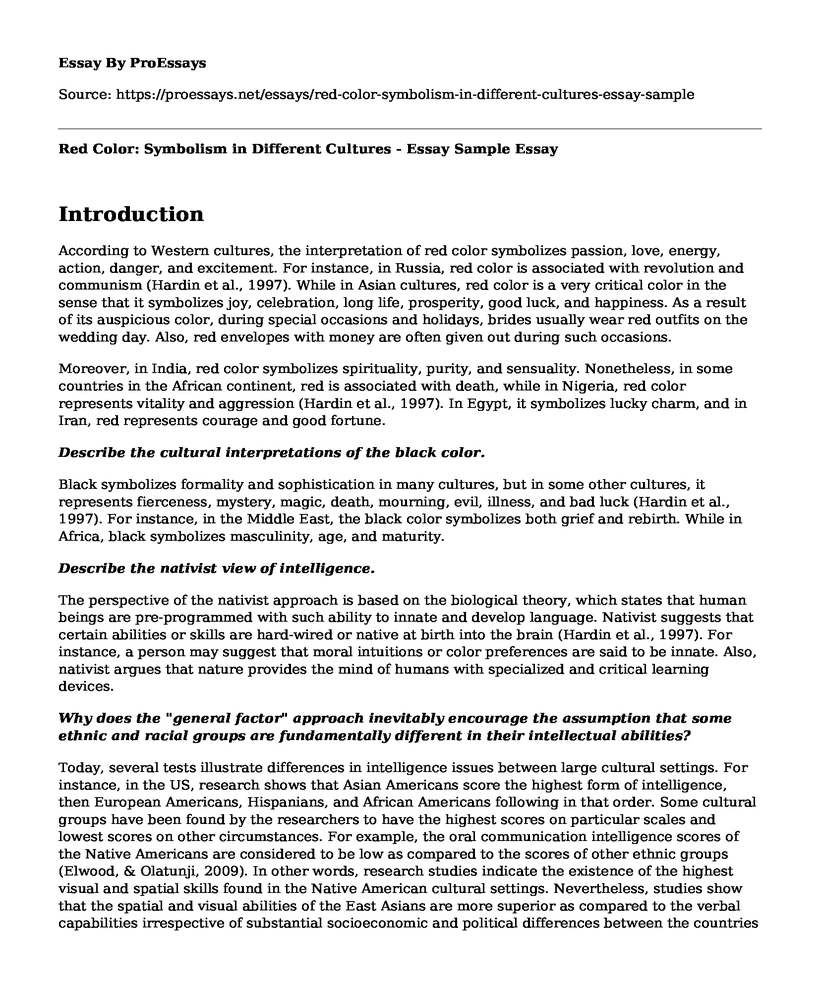Introduction
According to Western cultures, the interpretation of red color symbolizes passion, love, energy, action, danger, and excitement. For instance, in Russia, red color is associated with revolution and communism (Hardin et al., 1997). While in Asian cultures, red color is a very critical color in the sense that it symbolizes joy, celebration, long life, prosperity, good luck, and happiness. As a result of its auspicious color, during special occasions and holidays, brides usually wear red outfits on the wedding day. Also, red envelopes with money are often given out during such occasions.
Moreover, in India, red color symbolizes spirituality, purity, and sensuality. Nonetheless, in some countries in the African continent, red is associated with death, while in Nigeria, red color represents vitality and aggression (Hardin et al., 1997). In Egypt, it symbolizes lucky charm, and in Iran, red represents courage and good fortune.
Describe the cultural interpretations of the black color.
Black symbolizes formality and sophistication in many cultures, but in some other cultures, it represents fierceness, mystery, magic, death, mourning, evil, illness, and bad luck (Hardin et al., 1997). For instance, in the Middle East, the black color symbolizes both grief and rebirth. While in Africa, black symbolizes masculinity, age, and maturity.
Describe the nativist view of intelligence.
The perspective of the nativist approach is based on the biological theory, which states that human beings are pre-programmed with such ability to innate and develop language. Nativist suggests that certain abilities or skills are hard-wired or native at birth into the brain (Hardin et al., 1997). For instance, a person may suggest that moral intuitions or color preferences are said to be innate. Also, nativist argues that nature provides the mind of humans with specialized and critical learning devices.
Why does the "general factor" approach inevitably encourage the assumption that some ethnic and racial groups are fundamentally different in their intellectual abilities?
Today, several tests illustrate differences in intelligence issues between large cultural settings. For instance, in the US, research shows that Asian Americans score the highest form of intelligence, then European Americans, Hispanians, and African Americans following in that order. Some cultural groups have been found by the researchers to have the highest scores on particular scales and lowest scores on other circumstances. For example, the oral communication intelligence scores of the Native Americans are considered to be low as compared to the scores of other ethnic groups (Elwood, & Olatunji, 2009). In other words, research studies indicate the existence of the highest visual and spatial skills found in the Native American cultural settings. Nevertheless, studies show that the spatial and visual abilities of the East Asians are more superior as compared to the verbal capabilities irrespective of substantial socioeconomic and political differences between the countries in East Asia.
Why do Chinese students (according to empirical studies) evaluate "acceptance to college" as a more stressful event than do American students?
Concerning the empirical research studies, the Chinese students evaluate their college acceptance as most stressful as compared to the students in the United States because the process of acceptance between the two cultural settings is significantly different (Hardin et al., 1997). The system of basic and higher education in China bases the admission of students on very competitive oral and written exams. Students who, in one way or the other, have not been accepted have no otherwise but to wait for other years to apply again, unlike in the American system of education.
What are the most significant cross-cultural similarities of disgust?
In cross-cultural diversity, disgust is referred to as a fundamental human being's emotion that might be characterized by physiological responses, unique signals, as well as the thematic issue of antecedent occasions. In essence, cross-cultural research of disgust has analyzed each of these features. The characteristic which has received the most significant is the issue of facial expression that has been associated with such disgust (Elwood, & Olatunji, 2009). In this regard, the facial expression is associated with disgust emotions at higher rates more than the predicted rates by very many research studies, using different samples and methodologies. The analysis of recognizing disgust in isolated cases of cultural setting has produced mixed reactions with the participants giving high accuracy rates when examining the typical emotions with facial expression. Irrespective of these differences, people across such cultural settings have paired disgust emotion consistently with a facial expression that gives crucial support for universal experience of cross-cultural disgust emotion.
References
Elwood, L. S., & Olatunji, B. O. (2009). A cross-cultural perspective on disgust. American Psychological Association.
Hardin, C. L., Hardin, C. L., & Maffi, L. (Eds.). (1997). Color categories in thought and language. Cambridge University Press.
Cite this page
Red Color: Symbolism in Different Cultures - Essay Sample. (2023, Apr 12). Retrieved from https://proessays.net/essays/red-color-symbolism-in-different-cultures-essay-sample
If you are the original author of this essay and no longer wish to have it published on the ProEssays website, please click below to request its removal:
- Family Genetic Risks Analysis Paper Example
- Buddhism, Islam, and Christianity in Southeast Asia Essay Example
- Essay Sample on Family Theory and Domestic Violence
- Unequal Childhoods Interview Paper Example
- Essay Example on Night Market: A Cross-Cultural Experience of Asian Cuisine & Culture
- Paper Example on Exploring the Roots: Native Americans, Colonies, and the Formation of the United States
- Sperm Donor Anonymity in Australia: Legal Challenges and Proposed Frameworks - Free Paper







